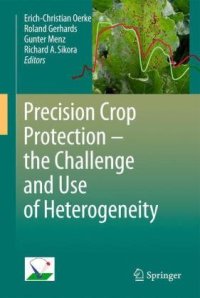
Ebook: Precision Crop Protection - the Challenge and Use of Heterogeneity
- Tags: Agriculture, Remote Sensing/Photogrammetry, Geotechnical Engineering & Applied Earth Sciences, Entomology
- Year: 2010
- Publisher: Springer Netherlands
- Edition: 1
- Language: English
- pdf
Precision farming is an agricultural management system using global navigation satellite systems, geographic information systems, remote sensing, and data management systems for optimizing the use of nutrients, water, seed, pesticides and energy in heterogeneous field situations. This book, generated by scientists from a broad range of scientific disciplines, provides extensive information on the state-of-the-art of research on precision crop protection and recent developments in site-specific application technologies for the management of weeds, arthropod pests, pathogens and nematodes. It gives the reader an up-to-date and in-depth review of both basic and applied research developments. The chapters discuss I) biology and epidemiology of pests, II) new sensor technologies, III) applications of multi-scale sensor systems, IV) sensor detection of pests in growing crops, V) spatial and non-spatial data management, VI) impact of pest heterogeneity and VII) precise mechanical and chemical pest control. Examples for the use of technologies are given for the management of pests which enable growers to vary application timing and dosage, and to optimize pesticide mixtures or intensity of mechanical weeding according to the spatial and temporal variability of pests.
Precision farming is an agricultural management system using global navigation satellite systems, geographic information systems, remote sensing, and data management systems for optimizing the use of nutrients, water, seed, pesticides and energy in heterogeneous field situations. This book provides extensive information on the state-of-the-art of research on precision crop protection and recent developments in site-specific application technologies for the management of weeds, arthropod pests, pathogens and nematodes. It gives the reader an up-to-date and in-depth review of both basic and applied research developments. The chapters discuss I) biology and epidemiology of pests, II) new sensor technologies, III) applications of multi-scale sensor systems, IV) sensor detection of pests in growing crops, V) spatial and non-spatial data management, VI) impact of pest heterogeneity and VII) precise mechanical and chemical pest control.